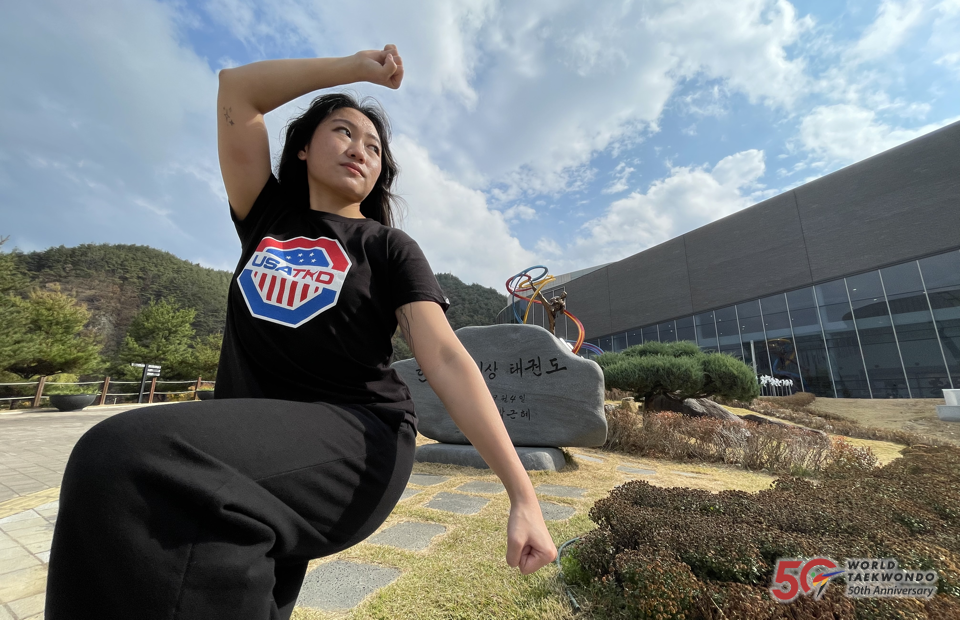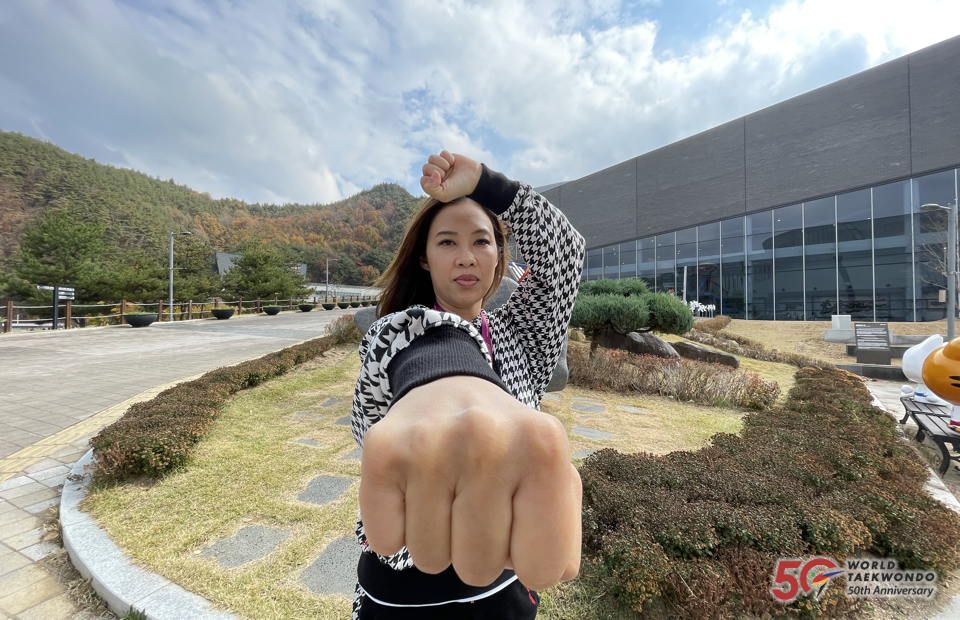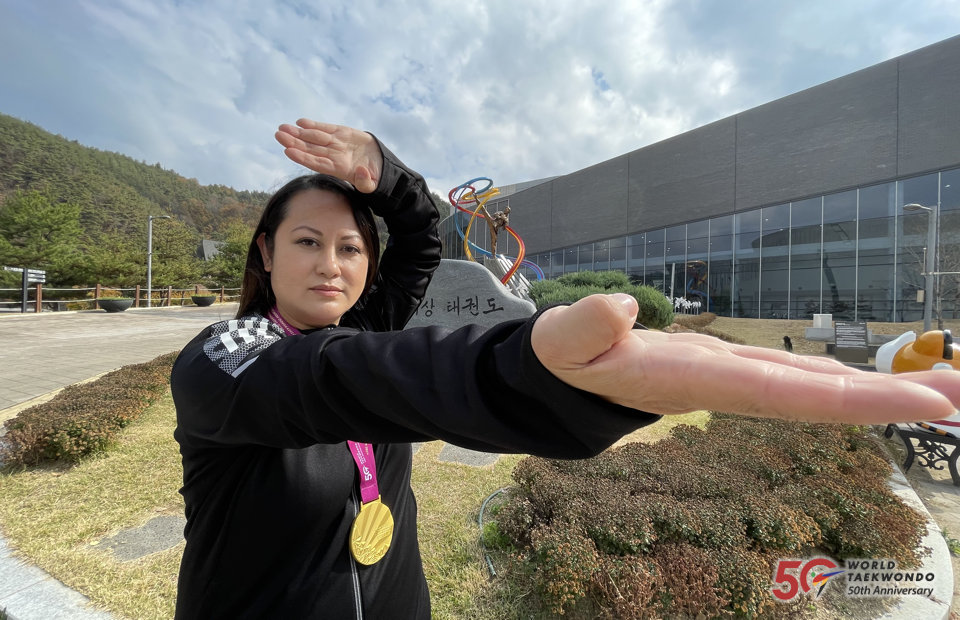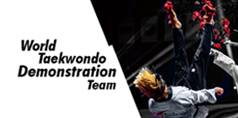
Team USA Gold Medallists (Female Division).
From left: Karyn Real, Jennifer Howard, Rosalynn Le, Elva Adams.
MUJU, Korea (Nov. 5, 2023) – While Team Korea topped the medal table at the Muju Taekwondowon 2023 World Taekwondo Poomsae Open Challenge, Team USA also took home a stack of gold.
First place in the National Team Individual Female Under 30 category was captured by Karyn Real – an achievement that netted the 22-year-old MIT student an automatic wild card place at 2024’s World Poomsae Championships in Hong Kong.
First place in the Female Team Over 30 was grabbed by the trio of Elva Adams, 53, Jennifer Howard, 45, and Rosalynn Le, 42.
To top it off, Adams struck yet another gold in the Individual Female Under 60 category.
The three-woman team call themselves “Team Wow.” Why so? “Team Wow” is “Team Mom” written upside down, they explain. All three coach Taekwondo; all three have jobs; and all three are mothers, with two children each.
For women with such weighty responsibilities to compete in an athletic event at the elite level is highly unusual. And that, they say, is the edge that poomsae (forms competition) offers over kyorugi (sparring competition).
“After the 2018 World Championships, I took a little break and had two kids,” said Le. “If it was any other sport, I would not have had the opportunity to come back.”
One issue is that poomsae, a non-contact format, does not deliver kyorugi’s kinetic shock to aging bodies.
“We were all kyorugi fighters before poomsae competitors” said Adams. “We eventually chose poomsae, as kyorugi competitors have very short athletic lives.”
Another issue is that it is easier for busy persons – like working mothers - to schedule poomsae training than kyorugi training. The former can be done solo; the latter requires partners/opponents.
“Poomsae is more about self-training, which is difficult to sustain as a kyorugi athlete,” said Howard. “Poosmae can be communal, but it is a lot of self-training and self-discipline.”
That factor, plus the need for zero physical equipment, makes poomsae a form of exercise appropriate for all times, in all spaces.
“You can practice on your own, any time, anywhere,” Howard added.
However, all three “Team Wow” members agree that Taekwondo trainees should build a broad foundation in the sport before specializing in one of the two competitive formats.
“I would consider Taekwondo as a whole: poomsae and kyorugi are like a double major, like an undergraduate,” said Le. “When you choose one, it is like getting your masters or your doctorate.”
Real – who, incidentally, is pursuing a double major in computer science and economics – points out that poomsae also opens doors for athletes with a wider range of physiques than kyorugi, which favors tall, leggy players, within the constraint of weight limits.
“I competed from a very young age in both sparring and poomsae until I was about 16, and the reason to turn toward poomsae was that you can still be competitive with a variety of body types,” she said. “I am on the shorter side, so it was hard to be competitive in sparring.”
Body types also have an influence on poomsae. Traditional poomsae are set routines, with each competitor performing the same techniques, in the same sequence.
Yet, space exists for self-expression.
“As far as accuracy, everyone is striving to create the same technical movements, but everyone has a different style: There is room for interpretation, rhythm and expression of energy,” Real said. “In my brother’s division, he is on the slimmer side and his competitors are bigger and typically have a more grounded style, so for him, his style is more speed and explosiveness.”
While kyorugi is a demanding, full-contact combat sport, its focus on safety, fairness and spectacular moves mean its techniques are not ideal for self-defense – one of the key reasons beginners take up a martial art.
Poomsae, on the other hand, provide a template of nitty-gritty self-defense techniques for coaches teaching grass-roots Taekwondo.
“There are textbooks on self-defense and poomsae, and I teach poomsae application in my school,” said Howard.
“When you compete, you lose some of that [realism],” added Adams – a reference to the emphasis on spectacle over effectiveness in poomsae competition. “But you have to teach applications, because that is why the movements were developed.”
Even non-competitive level poomsae requires a demanding mixture of attributes: power and speed; balance and agility; precision and grace. At the competitive level there is an additional demand for focus and concentration due to the time limit.
“You have one, short time – maximum is one minute, 30 seconds - so that is what makes it really demanding both mentally and physically,” Adams said.
That is a very and unforgiving short time within which to deliver a perfect performance. But in poomsae, like every other human activity, perfection is an impossible goal.
“Poomsae is like golf,” said Howard. “It can never be perfected.”
To win in this discipline, Real offers some Zen-like advice that may be prove as applicable to life as it is to Taekwondo.
“For me, personally, I find most success when I think that I don’t want to win, I want to do good poomsae – poomsae that, when I look back at on video, I will be proud of,” she said. “That helps me to achieve the best possible result.”








































